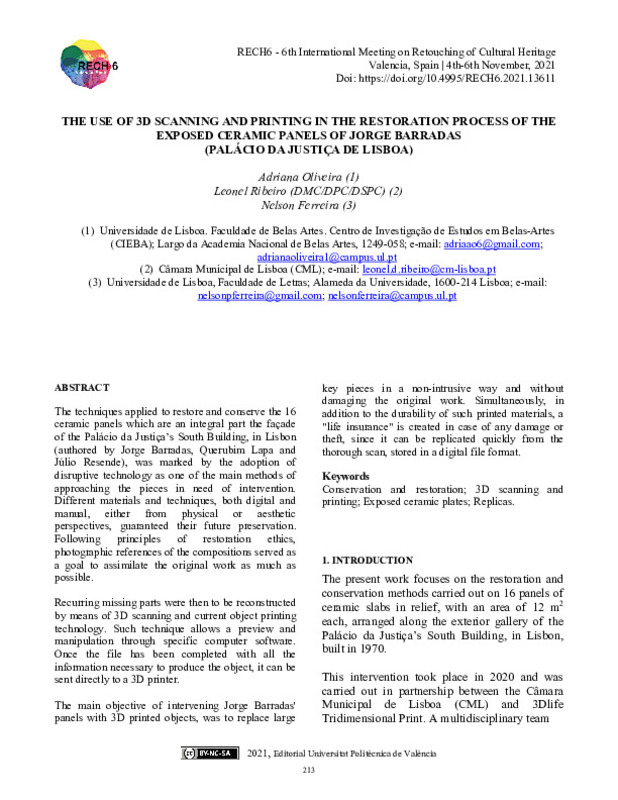JavaScript is disabled for your browser. Some features of this site may not work without it.
Buscar en RiuNet
Listar
Mi cuenta
Estadísticas
Ayuda RiuNet
Admin. UPV
The use of 3D scanning and printing in the restoration process of the exposed ceramic panels of Jorge Barradas (Palàcio da Justiça de Lisboa)
Mostrar el registro sencillo del ítem
Ficheros en el ítem
| dc.contributor.author | Oliveira, Adriana
|
es_ES |
| dc.contributor.author | Ferreira, Nelson
|
es_ES |
| dc.contributor.author | Ribeiro, Leonel
|
es_ES |
| dc.date.accessioned | 2023-01-19T09:51:38Z | |
| dc.date.available | 2023-01-19T09:51:38Z | |
| dc.date.issued | 2023-01-11 | |
| dc.identifier.isbn | 9788413960258 | |
| dc.identifier.uri | http://hdl.handle.net/10251/191401 | |
| dc.description.abstract | [ES] Las técnicas aplicadas a la restauración y conservación de los 16 paneles cerámicos que forman parte integrante de la fachada del Edificio Sur del Palácio da Justiça, en Lisboa (obra de de Jorge Barradas, Querubim Lapa y Júlio Resende), ha marcadas por la adopción de tecnología disruptiva como uno de los principales métodos de aproximación a las piezas necesitadas de intervención. Se han aplicado diferentes materiales y técnicas, tanto digitales como manuales, desde perspectivas físicas o estéticas, para garantizar su futura conservación. Siguiendo los principios de la ética de la restauración, las referencias fotográficas de las composiciones sirvieron como objetivo para asimilar al máximo la obra original. A continuación, las partes que faltaban debían reconstruirse mediante escaneado 3D y la tecnología actual de impresión de objetos. Dicha técnica permite una previsualización y manipulación a través de un software informático específico. Una vez completado el archivo con toda la información necesaria para producir el objeto, se ha enviado directamente a una impresora 3D. El objetivo principal de intervenir los paneles de Jorge Barradas con objetos impresos en 3D, era sustituir grandes piezas clave de la obra de forma no intrusiva y sin dañar la obra original. Simultáneamente, además de la durabilidad de estos materiales impresos, se crea un "seguro de vida" en caso de cualquier daño o robo, ya que se puede replicar rápidamente a partir del escaneado minucioso, almacenado en un formato de archivo digital. | es_ES |
| dc.description.abstract | [EN] The techniques applied to restore and conserve the 16 ceramic panels which are an integral part the façade of the Palácio da Justiça’s South Building, in Lisbon (authored by Jorge Barradas, Querubim Lapa and Júlio Resende), was marked by the adoption of disruptive technology as one of the main methods of approaching the pieces in need of intervention. Different materials and techniques, both digital and manual, either from physical or aesthetic perspectives, guaranteed their future preservation. Following principles of restoration ethics, photographic references of the compositions served as a goal to assimilate the original work as much as possible. Recurring missing parts were then to be reconstructed by means of 3D scanning and current object printing technology. Such technique allows a preview and manipulation through specific computer software. Once the file has been completed with all the information necessary to produce the object, it can be sent directly to a 3D printer. The main objective of intervening Jorge Barradas' panels with 3D printed objects, was to replace large key pieces in a non-intrusive way and without damaging the original work. Simultaneously, in addition to the durability of such printed materials, a "life insurance" is created in case of any damage or theft, since it can be replicated quickly from the thorough scan, stored in a digital file format. | es_ES |
| dc.format.extent | 8 | es_ES |
| dc.language | Inglés | es_ES |
| dc.publisher | Editorial Universitat Politècnica de València | es_ES |
| dc.relation.ispartof | 6th International Meeting on Retouching of Cultural Heritage, RECH6 | |
| dc.rights | Reconocimiento - No comercial - Compartir igual (by-nc-sa) | es_ES |
| dc.subject | Júlio Martins Resende da Silva Dias (1917-2011) | es_ES |
| dc.subject | Querubim Lapa de Almeida (1925-2016) | es_ES |
| dc.subject | Conservación y restauración de bienes culturales | es_ES |
| dc.subject | Jorge Barradas (1894 -1971) | es_ES |
| dc.subject | Paneles cerámicos | es_ES |
| dc.subject | 3D printing | es_ES |
| dc.subject | 3D scanning | es_ES |
| dc.subject | Conservation and restoration | es_ES |
| dc.subject | Ceramic plates | es_ES |
| dc.title | The use of 3D scanning and printing in the restoration process of the exposed ceramic panels of Jorge Barradas (Palàcio da Justiça de Lisboa) | es_ES |
| dc.type | Capítulo de libro | es_ES |
| dc.type | Comunicación en congreso | es_ES |
| dc.identifier.doi | 10.4995/RECH6.2021.13611 | |
| dc.rights.accessRights | Abierto | es_ES |
| dc.description.bibliographicCitation | Oliveira, A.; Ferreira, N.; Ribeiro, L. (2023). The use of 3D scanning and printing in the restoration process of the exposed ceramic panels of Jorge Barradas (Palàcio da Justiça de Lisboa). En 6th International Meeting on Retouching of Cultural Heritage, RECH6. Editorial Universitat Politècnica de València. 213-220. https://doi.org/10.4995/RECH6.2021.13611 | es_ES |
| dc.description.accrualMethod | OCS | es_ES |
| dc.relation.conferencename | RECH6 - 6th International Meeting on Retouching of Cultural Heritage | es_ES |
| dc.relation.conferencedate | Noviembre 04-05, 2021 | es_ES |
| dc.relation.conferenceplace | Valencia, España | es_ES |
| dc.relation.publisherversion | http://ocs.editorial.upv.es/index.php/RECH/RECH6/paper/view/13611 | es_ES |
| dc.description.upvformatpinicio | 213 | es_ES |
| dc.description.upvformatpfin | 220 | es_ES |
| dc.type.version | info:eu-repo/semantics/publishedVersion | es_ES |
| dc.relation.pasarela | OCS\13611 | es_ES |








